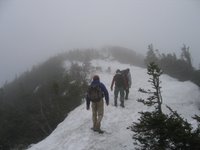Now it was time to head for the last peek of the trip: Gothics. The trail from Armstrong to Gothics was still covered in snow and ice. Our progress was slowed as our feet continually broke through the snow sending us knee to waist deep. The final ascent of Gothics from this side was a fairly gradual snow covered trail which could have doubled as a ski slope.

The ascent up Gothics. It was certainly still winter up here. (5/6/06, 3:45 p.m.)
Without too much difficulty (besides frequent sinking in the snow), we made it to the summit.

In lieu of a decent view from the summit (due to the weather again), here is the marker placed on the summit by the U.S. Geological Survey. (5/6/06, 3:52 p.m.)
Now came the major difficulty -- descending Gothics. The trail down was mostly steep, bare rock. For several portions, the NYS Department of Environmental Conservation (NYSDEC) has attached cables to the rock to aid in the descent. This is a tricky descent even on dry rock in good weather. We were going to have to navigate it wet.
There are no cables for the initial descent from the summit, so we slowly edged our way down the wet rock trying to keep as solid of footing as possible. We stayed as low as possible to the ground in order that we be prepared for the inevitable "butt-slide." This is when you sit (either intentially or not) with your butt on the rock, your feet in front of you, and your hands to your side (or behind) as you slide down a steep or slippery portion of rock.
Indeed, the butt-slides came quickly for everyone but Adam. Ed went down first early on the rock face, but was able to stop his slide after only a few feet. Seth went down next just a few seconds after. He was able to stop his slide and regain his footing after several yards. I was ahead (slightly further in the descent) looking back toward where Seth had just fallen. My feet were firmly planted on the rock with what I thought was solid footing. Before I knew what had happened, my feet had slipped out from under me on the wet rock and I was in my own butt-slide, heading uncontrollable down the sheer, wet mountain face. I pressed my boots and my bare hands against the rock to attempt to slow my slide to no avail. Looking up, I could see a narrow crevass, about two feet wide, in the rock ahead of me -- I was heading directly toward it. I prepared to brace my legs on the far side of the crevass as I approached to halt my slide. I hoped for two things: that the crevass wasn't too deep and that I would be able to stop before going in.
My legs hit the far wall of the crevass once, rebounding off as my slide continued. I quickly pushed my legs forward again, this time my boots took grip on the rock and I came to a halt -- my legs extending over what turned out to be about a six-foot deep crack in the rock. I sat motionless for a moment to regain my composure after this startling, to say the least, turn of events. It wasn't until a few seconds later that I felt the burning in my hands. This whole time they had been sliding across bare rock. Looking down at them they were red and raw to the touch. Several small cuts ran along the length of my palm. Too bad I wasn't wearing my gloves -- they were left at base camp too.
I took a good minute or two in this spot before even attempting to move again. When I did begin again, I slowly creeped my way down the length of this crack in the rock by bracing my feet on the far wall. It was only another 30-feet or so down to the first level portion in the rock. This would give us a place to stop before we began the descent down the cables.

The initial rock face we were descending (taken from a small leveling below). This is where 3 out of 4 of us went down. Unfortunately, the crack I stopped myself on doesn't appear in this picture. This was steep, wet, and overall a big mess. (5/6/06, 4:15 p.m.)
Next, we had the cables. These ran over similar rock faces to that shown above and proved to be a tremendous help in the climb down. By holding onto these cables as we descended, we were able to avoid a repeat of the events described above. Needless to say, it still wasn't exactly a walk in the park.

The initial cabled descent. From highest-elevation to lowest-elevation: Myself, Ed, Adam. (5/6/06, 4:16 p.m.)

Another shot of the cable descent. (5/6/06, 4:17 p.m.)

Looking up as Seth makes his descent down the cables. (5/6/06, 4:19 p.m.)
We slowly made our way down several sets of cables and off the sheer rock face. After this rapid elevation change, we expected the rest of the hike back to camp to be a fairly easy couple of miles down the Ore Bed Brook Trail. Once again, we couldn't have been more wrong.



















